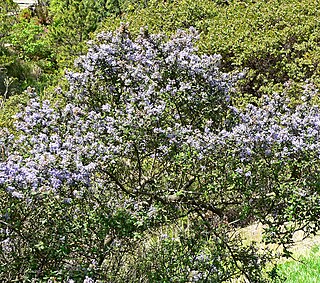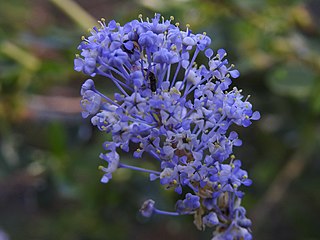Sycamore is a name which has been applied to several types of trees, but with somewhat similar leaf forms. The name derives from the ancient Greek συκόμορος (sūkomoros) meaning "fig-mulberry".
Cypress is a common name for various coniferous trees or shrubs of northern temperate regions that belong to the family Cupressaceae. The word cypress is derived from Old French cipres, which was imported from Latin cypressus, the latinisation of the Greek κυπάρισσος (kyparissos). Cypress trees are a large classification of conifers, encompassing the trees and shrubs from the cypress family (Cupressaceae) and many others with the word “cypress” in their common name. Many cypress trees have needle-like, evergreen foliage and acorn-like seed cones.
Gray squirrel or grey squirrel may refer to several species of squirrel indigenous to North America:

The Rhamnaceae are a large family of flowering plants, mostly trees, shrubs, and some vines, commonly called the buckthorn family. Rhamnaceae is included in the order Rosales.

Ceanothus is a genus of about 50–60 species of nitrogen-fixing shrubs and small trees in the buckthorn family (Rhamnaceae). Common names for members of this genus are buckbrush, California lilac, soap bush, or just ceanothus. "Ceanothus" comes from Ancient Greek: κεάνωθος (keanōthos), which was applied by Theophrastus to an Old World plant believed to be Cirsium arvense.
Poison oak refers to two plant species in the genus Toxicodendron, both of which can cause skin irritation:

The Northern California coastal forests are a temperate coniferous forests ecoregion of coastal Northern California and southwestern Oregon.
Red snapper is a common name of several fish species. It may refer to:
Soapbush or soap bush can mean:

Ceanothus cuneatus is a species of flowering shrub known by the common names buckbrush and wedgeleaf ceanothus.

Ceanothus megacarpus is a species of flowering shrub known by the common name bigpod ceanothus. This Ceanothus is endemic to California, where its distribution extends along the Central Coast and includes the Channel Islands.

Ceanothus impressus is a species of shrub in the family Rhamnaceae known by the common name Santa Barbara ceanothus. It is endemic to the Central Coast of California, where it is known from San Luis Obispo and Santa Barbara Counties. It occurs in chaparral habitat.

Ceanothus fendleri is a species of flowering shrub native to northern Mexico, Arizona, New Mexico, west Texas and the northeastern Texas panhandle, Utah, Colorado, eastern Wyoming, and western South Dakota. Its typical habitat is pine forests from 1,500 to 3,000 meters in altitude.
Redroot is the common name of some plants:

Ceanothus parvifolius is a species of shrub in the family Rhamnaceae known by the common name littleleaf ceanothus or littleleaf whitethorn. This deciduous plant is characterized by its blue flowers and flat topped habit, and is endemic to the Sierra Nevada of California, where it grows on mountain flats and coniferous forest.

Ceanothus purpureus, with the common name hollyleaf ceanothus, is a species of shrub in the family Rhamnaceae. It is endemic to northern California, where it is known only from the Inner North Coast Ranges north of the Bay Area, mainly in Sonoma and Napa Counties. The largest remaining population of this shrub occurs on Mt. George near Napa, where it is protected in a botanical preserve.

Ceanothus sanguineus is a species of shrub in the family Rhamnaceae known by the common name redstem ceanothus. It is native to western North America from British Columbia to Montana to far northern California; it is also known from Michigan. It grows in temperate coniferous forest habitat in forest openings amidst the conifers. This is an erect shrub approaching 3 meters in maximum height. Its stem is red to purple in color, its woody parts green and hairless when new. The deciduous leaves are alternately arranged and up to about 10 centimeters long. They are thin, light green, oval, and generally edged with glandular teeth. The undersides are sometimes hairy. The inflorescence is a cluster of white flowers up to about 12 centimeters long. The fruit is a three-lobed smooth capsule about 4 millimeters long. This shrub is an important food plant for wild ungulates such as the Rocky Mountain Elk, it is browsed eagerly by many types of livestock, and the seed is consumed by many types of animals.

Ceanothus velutinus, with the common names snowbrush ceanothus, red root, and tobacco brush, is a species of shrub in the family Rhamnaceae. It is native to western North America from British Columbia to California to Colorado, where it grows in several habitat types including coniferous forest, chaparral, and various types of woodland.

Ceanothus americanus is a species of Ceanothus shrub native to North America. Common names include New Jersey tea, Jersey tea ceanothus, variations of red root, mountain sweet, and wild snowball. New Jersey tea was a name coined during the American Revolution, because its leaves were used as a substitute for imported tea.
This page is based on this
Wikipedia article Text is available under the
CC BY-SA 4.0 license; additional terms may apply.
Images, videos and audio are available under their respective licenses.











